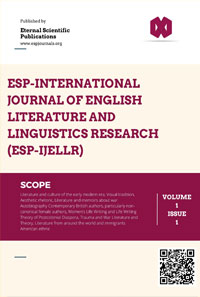ESP International Journal of English Literature and Linguistics Research (ESP-IJELLR)
Citation :
C. Vijayalakshmi, Chanda Asani, 2025. "Forensic Linguistics: Language Use in Legal Settings in Tamil Nadu" ESP-International Journal of English Literature and Linguistics Research (ESP- IJELLR) Volume 3, Issue 2: 1-8.
Abstract :
The study of language in legal contexts, or forensic linguistics, has emerged as an important aspect of modern day law and forensics. It is the analysis of oral and written language including statements in order to:1) establish facts,2) clarify issues, and 3)support evidence. Forensic linguistics offers much in the way of promise for enhancing precision and fairness in court cases in Tamil Nadu, an Indian state with a heterogeneous population. In a multilingual setting such as that of Tamil Nadu, where English, the indigenous language (Tamil), and other regional languages are used in official and judicial functions, 3 forensic linguistic implications face strengths and weaknesses.This essay investigates the role of language in Tamil Nadu’s many legal domains, and concentrates on courtroom activities, interrogations, and legal records. In criminal investigations, forensic linguistics is employed to examine texts such as emails, letters and social media posts, in a bid to attribute its creation; to detect deception and intention. The real-world utility of speech/linguistic evidence in crime investigations can be seen with an NFL team's recent reliance on speaker identification and forensic phonetics to resolve matters concerning a threat directed at them as well as the increased usage of voice/speech analysis by law enforcement agencies to clear up instances of anonymous threats or hoax calls. Linguistic analysis minimizes misunderstandings that can lead to wrongful convictions by enabling artifacts, statements or testimony and confessions to be accurately interpreted in all phases of court proceedings. In a fashion like this, it has been well documented also that forensics document examiners have been scrutinizing legal documents such as: Wills Contracts Affidavits To assist the Criminal and Civil court systems to determine Attaching of a signature to the paper Identifying forgery Evaluate intent. Case study from Tamil Nadu highlight forensics linguistics and its application in spying, in uncovering fraud using forensic linguistics such as authorship of Tamil language emails, voice analysis relating to crimes proving useful at some level.The complexity of multilingual communication, limited availability of advanced linguistic devices and an absence of testyed procedures for judicial appreciation of linguistic evidence are some impediments posed to forensic linguistics in Tamil Nadu despite its prospect. But recent advances in technology, interdisciplinary cooperation and training are enhancing the field’s ability. Higher-level applications are becoming feasible due to dedicated education programs, as well as advances in automatic speech recognition and natural language processing, and interplay among linguists, law enforcement offer and legal professionals. As the paper concludes, forensic linguistics is necessary in closing the gap between language and law in Tamil Nadu. Systematic linguistic analysis enhances accuracy, fairness and legitimacy of legal processes. The importance of forensic linguistics in the law courts of Tamil Nadu will be more firmly grounded by future research, technological development, and training.
References :
[1] Pandian, A., & Sadiq, A. K. (2025). Authorship attribution in Tamil language email for forensic analysis. ResearchGate. Retrieved from https://www.researchgate.net/publication/286941833_Authorship_attribution_in_tamil_language_email_for_forensic_analysis
[2] Times of India. (2023, September 13). TN cops add voice analysis as forensic tool to crack crime. Times of India. Retrieved from https://timesofindia.indiatimes.com/city/chennai/tn-cops-add-voice-analysis-as-forensic-tool-to-crack-crime/articleshow/103623936.cms
[3] Toppo, R. (2023). Evaluating and accessing the scope of forensic linguistics in a multilingual context. Language in India. Retrieved from https://www.languageinindia.com/aug2023/ravinaforensiclinguisticsmultilingualcontext.pdf
[4] Srinivasan, M. (2024). Advancements in forensic voice analysis: Legal frameworks and technology integration. Asian Journal of Interdisciplinary Research. Retrieved from https://jasianresearch.com/index.php/AJOAIR/article/download/464/499/739
[5] Pandian, A., & Sadiq, A. K. (2025). Innovative methods in identifying authors of documents. ResearchGate. Retrieved from https://www.researchgate.net/publication/270573447_Innovative_Methods_in_Identifying_Authors_of_Documents
[6] Syam, S. (2018). Aspects of forensic linguistics in policing. Language in India. Retrieved from https://www.languageinindia.com/dec2018/drsyamforensiclinguisticspolicing.pdf
[7] Vijay, N., & Madhu, J. (2014). Forensic linguistics: An introduction to language, crime, and the law. Academia.edu. Retrieved from https://www.academia.edu/36251502/Handbook_of_the_Three_day_workshop_on_Forensic_Linguistics
[8] Toppo, R. (2023). A critical appraisal of the salience of forensic linguistics in the Indian legal system. SpringerLink. Retrieved from https://link.springer.com/10.1007/s11196-025-10355-z
[9] Vijay, N., & Madhu, J. (2014). Forensic linguistics: An introduction to language, crime, and the law. Academia.edu. Retrieved from https://www.academia.edu/36251502/Handbook_of_the_Three_day_workshop_on_Forensic_Linguistics
[10] Syam, S. (2018). Aspects of forensic linguistics in policing. Language in India. Retrieved from https://www.languageinindia.com/dec2018/drsyamforensiclinguisticspolicing.pdf
[11] Pandian, A., & Sadiq, A. K. (2025). Innovative methods in identifying authors of documents. ResearchGate. Retrieved from https://www.researchgate.net/publication/270573447_Innovative_Methods_in_Identifying_Authors_of_Documents
[12] Toppo, R. (2023). Evaluating and accessing the scope of forensic linguistics in a multilingual context. Language in India. Retrieved from https://www.languageinindia.com/aug2023/ravinaforensiclinguisticsmultilingualcontext.pdf
[13] Srinivasan, M. (2024). Advancements in forensic voice analysis: Legal frameworks and technology integration. Asian Journal of Interdisciplinary Research. Retrieved from https://jasianresearch.com/index.php/AJOAIR/article/download/464/499/739
[14] Pandian, A., & Sadiq, A. K. (2025). Authorship attribution in Tamil language email for forensic analysis. ResearchGate. Retrieved from https://www.researchgate.net/publication/286941833_Authorship_attribution_in_tamil_language_email_for_forensic_analysis
[15] Syam, S. (2018). Aspects of forensic linguistics in policing. Language in India. Retrieved from https://www.languageinindia.com/dec2018/drsyamforensiclinguisticspolicing.pdf
[16] Vijay, N., & Madhu, J. (2014). Forensic linguistics: An introduction to language, crime, and the law. Academia.edu. Retrieved from https://www.academia.edu/36251502/Handbook_of_the_Three_day_workshop_on_Forensic_Linguistics
[17] Toppo, R. (2023). A critical appraisal of the salience of forensic linguistics in the Indian legal system. SpringerLink. Retrieved from https://link.springer.com/10.1007/s11196-025-10355-z
[18] Vijay, N., & Madhu, J. (2014). Forensic linguistics: An introduction to language, crime, and the law. Academia.edu. Retrieved from [https://www.academia.edu/36251502/Handbook_of_the_Three_day_workshop_on_Forensic_Linguistics](https://www.academia.edu/36251502/Handbook_of_the_Three_day
Keywords :
Courtroom Interpretation, Multilingual Law, Legal Documents, Forensic Linguistics, Legal Language, Tamil Nadu, Authorship Attribution, Voice Analysis, Speech Analysis.


 :10.56472/25842773/IJELLR-V3I2P101
:10.56472/25842773/IJELLR-V3I2P101